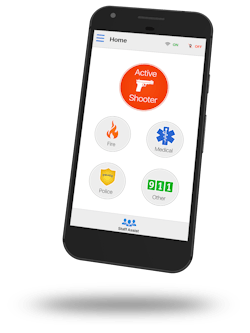Technology Improves Notification, Intelligence In Active Shooter Events
New research published in the Journal of Child and Family Studies has found that more people have died or been injured in mass school shootings in the U.S. in the past 18 years than in the entire 20th century. From Sandy Hook to Parkland, recent active shooter events in schools have many law enforcement agencies and school administration taking a second look at security measures in place at every educational institution. Adequate response time and information have been barriers, but newer technologies aim to empower law enforcement and school staff during these catastrophic events by helping to promote rapid notification, decrease response times and increase real-time intelligence.
When a school fights back
After Columbine and proceeding school shootings, Mike Kersey, a 26-year law enforcement veteran and commander of the Montgomery County (Ind.) SWAT team, began to ponder the hurdles law enforcement faced responding to these events. “We have always been caught outside of the reactionary gap and I wanted to find a way to change it,” he says. Kersey points to several challenges law enforcement has had when it comes to active shooter response—there’s a lack of rapid notification, a lack of protected spaces for students already in the building and a lack of real-time information for law enforcement showing up at the scene.
When searching for solutions to help law enforcement during an active shooter event, Kersey had a checklist of ‘must-haves’. He wanted to find a way to get law enforcement on the scene faster; he wanted to get actionable intelligence to first responders and dispatch; he wanted to give would-be victims better protective spaces to avoid the shooter; he wanted the ability to separate the attacker from students and teachers; and he wanted the ability to interrupt the attack prior to law enforcement getting on scene. He was looking for a school to fight back. It seemed an impossible task until Kersey came across NetTalon.
The mission of the NetTalon security system is to stop an active shooter attack in the first minute using a variety of methods. The school is connected directly to the County Sheriff’s E9-1-1 Call Centers via VPN where two tactical workstations receive an alert and actionable intelligence.
Teachers are issued a fob, programmed to receivers in their area of the school. If an active shooter or emergency event occurs, the teacher would use their fob to send a RF signal to the receiver, which immediately triggers a call to 911 and turns on strobes and horns throughout the hallways and in the classrooms. At that moment, key stakeholders including school, law enforcement and fire administration officials, receive texts that an alert has been activated. Information coming from the signaling stations in the classroom enables responders to know the status of each classroom in real time, adding a tremendous benefit for responders, especially when it comes to possible wounded. “We are able then to concentrate resources to prioritize rescue in those rooms first to increase survivability,” says Kersey.
The system arms sensors that trigger access to live surveillance video feeds from within the school for dispatch to view, allowing better target and weapon identification. All of this happens in 40 seconds, says Don Jones, president of NetTalon. Once the system arms, there is the ability to track the intruder independently of the camera system, through a series of sensors.
Now that dispatch has eyes on the attacker, the countermeasures can be deployed. Each hallway in the school is equipped with canisters that, when deployed, shoot out a huge amount of chemical to disorient the attacker and block his/her vision. “When countermeasures are fired, the fire doors in hallways close,” says Jones. “So now the attacker is compartmentalized in one hallway. This is all under control by the communications officers in dispatch, who can continue to track the attacker and communicate his position to law enforcement still en-route.”
With this system in place a solo officer can enter a school and receive information immediately from dispatch, says Kersey. “It’s like having someone ahead of you clearing the hallways, so you can go right to contact as opposed to wondering where it is. It makes our movements and our tactics much more effective.”
What about the rest of the staff and students seeking shelter? Jones says the system in place gives them protection, too. The classroom doors are hybrid ballistic doors that are designed to deny a breach and minimize any rifle rounds into the classroom. “By having a hardened door and changing the location of the vision window, you’re minimizing where the rounds can go into a classroom and giving students and staff a better chance of survival,” says Jones. In essence, the intent was not to just be reactionary to the active killer threat alone, but take a comprehensive, holistic approach. “Parts of the system and protocols implemented serve in redundancy for other types of crisis responses,” says Kersey.
The system, currently in place at a high school in Shelby County, Ind., seems straight from a sci-fi thriller, but it allows both law enforcement and school staff the ability to react and respond quickly.
Wearable technology
One of the biggest benefits of many of today’s emergency response technologies is that they empower both law enforcement and school“We do this via a software and hardware platform integrated with Wi-Fi,” says Kennedy. “We have APIs that are designed to tell the building security that there is an incident at X location so the cameras can be focused there as well.” In the event that a less critical emergency occurs, a teacher can also press one of two colored buttons on the badge in order to request immediate assistance from someone such as the SRO. Two-way messaging also allows dispatchers to send mass communication texts to badge-holders, allowing dispatch to not only see where badge holders are in the school, but to communicate information to them as well.
Although teachers need to physically wear the AiRISTA Flow badge, other technologies available today utilize instruments teachers already carry with them on a daily basis—their smartphones.
Technology in the teacher’s hand
Recognizing the potential of mobile apps, in 2015 the state of Arkansas took a legislative step to ensure a fast first responder response to active shooter events by announcing that every public school would be protected by the Rave Panic Button, a technology designed and developed by Rave Mobile Safety. One of the most important missions of the system, says Noah Reiter, Rave’s vice president of customer success, is to reduce internal reaction time of the staff inside the building. “Our panic button app puts in the hands of each of the employees in the school a powerful communications tool that simultaneously dials 911 and also provides an immediate notification to their co-workers who need to know about the type of emergency that they are reporting so they can take immediate action,” says Reiter.The Rave Panic Button is part of an integrated platform that closely involves the school, law enforcement and dispatch. There are five primary buttons on the mobile app [shown in the image on page 16]—a prominently featured active shooter button and a fire, medical, general police and 911 ‘catch all’ button. All five buttons dial 911 natively over the wireless network and depending on which button is pressed, the app notifies groups of employees, pre-determined by the school and first responders. While the app can be a standalone system, it integrates with the Rave 911 Suite, which among other things, includes a facility profile and the ability for call takers to initiate two-way text conversations.
In 2016, Marion High School in Marion, Kan., successfully triggered a school lockdown with the Rave Panic Button after one student overheard another student brag about bringing a firearm to school. The student notified a teacher who immediately activated the “Active Shooter” button on the app, which initiated a lockdown and simultaneously notified 911 and faculty. Within minutes the student was apprehended and the gun was secure.
Giving teachers the ability to notify law enforcement quickly can cut response times from minutes to seconds. In rural Dixie County, Fla., response time to calls is about 15 minutes, but that was dramatically cut when a teacher activated a new mobile app that connects law enforcement and school staff. The Hero911 smartphone app resides on a credentialed law enforcement officer’s phone, downloadable free of charge. Meanwhile, teachers, administrators and school staff have a school version of the app, called the SchoolGuard Panic Button, giving them the ability to send that emergency alert to nearby Hero911 app users.
In the case in Dixie County, Fla., a teacher saw an individual on school property firing a weapon and after activating the SchoolGuard alert, the first police officer was on scene within three minutes, a drastic decrease in response time. The difference between this app and others is that the Hero911 app alerts any police officer within a set geographic range that has the Hero911 app, including federal agents, state troopers, county deputies, etc. If law enforcement is in close proximity to a school that has activated the SchoolGuard button, they would receive an immediate notification and GPS location within 150 feet of where the alert was initiated. Once the app is activated by a teacher or school staff, it not only notifies law enforcement right away but simultaneously dials 911, too.
Whether the technology is a fully integrated school with dispatch-controlled countermeasures or a mobile app that sends a duress signal at the push of a button, new tools help to create more secure schools and allow for quicker notification, faster response times, real-time intelligence, increased two-way communications and much more.
Look To Fire For Examples
In 2015 when a man in Lafayette, La., went into a movie theater and shot and killed two people, one of the victims in the theater jumped up and pulled the fire alarm. “When she did that, she got a response, but it wasn’t the correct response,” says Jeff LeDuff, former chief of police in Baton Rouge, La., and current CEO of Open Eyes Training. “Fire can’t help you when someone is shooting.” Fire codes dictate a plethora of standards, yet when it comes to active shooter events, LeDuff says, there are no set safety standards in place at schools. He points to BluePoint Alert Solution as a step in the right direction—it’s a technology that acts like a fire alarm but for police. The box, or ‘pull station’, looks similar to a fire alarm and when activated, it alerts police and building occupants immediately and among other things, sends the command group a text or email with a secure link to the Command & Control portal. “The thing that gets people hurt is lack of information and reaction time,” says LeDuff. The technology is currently being used in more than 150 schools in the U.S.
About the Author

Adrienne Zimmer
Editor
Adrienne Zimmer was the Editor of Law Enforcement Technology magazine, a monthly business-to-business publication that covers technology trends and best practices for public safety managers from 2017 to 2019. LET is part of Officer Media Group, which also publishes Law Enforcement Product News and Officer.com. Adrienne has been in publishing since 2013.


